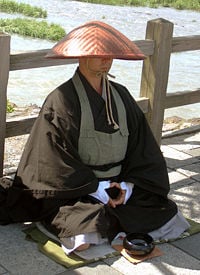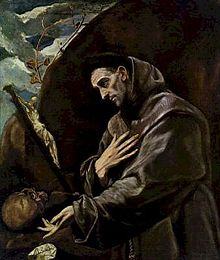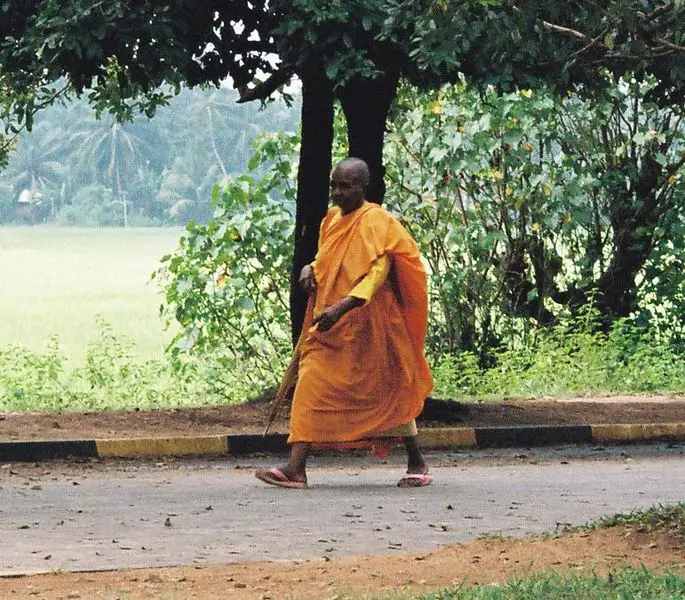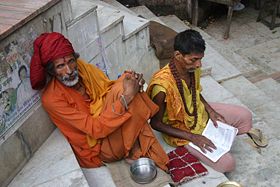Difference between revisions of "Mendicant" - New World Encyclopedia
Scott Dunbar (talk | contribs) (Images OK) |
Scott Dunbar (talk | contribs) m |
||
| Line 2: | Line 2: | ||
[[Image:Japanese_buddhist_monk_by_Arashiyama_cut.jpg|thumb|200 px|Begging [[Soto]] monk]] | [[Image:Japanese_buddhist_monk_by_Arashiyama_cut.jpg|thumb|200 px|Begging [[Soto]] monk]] | ||
| − | The term '''mendicant''' (Latin: ''mendicans'', meaning "begging") | + | The term '''mendicant''' (Latin: ''mendicans'', meaning "begging") pertains to [[religion|religious]] followers and [[asceticism|ascetics]] who rely exclusively on begging for charity to survive. |
| − | In principle, mendcants ( | + | In principle, mendcants (and religious mendicant orders) do not own property, either individually or collectively, and have taken a vow of poverty, in order that all their time and energy could be expended on practicing or preaching their religion or way of life and serving the poor. |
The term "mendicant" may be used to refer to both Christian and non-Christian ascetics, such as [[Buddhism|Buddhist]] monks and [[Hinduism|Hindu]] holysscetics, and some [[dervishes]] of [[Sufism|Sufi]] [[Islam]]. In [[Theravada]] Buddhism, mendicants are knwn by the terms bhikkhu (male) and Bhikkhuni (female). | The term "mendicant" may be used to refer to both Christian and non-Christian ascetics, such as [[Buddhism|Buddhist]] monks and [[Hinduism|Hindu]] holysscetics, and some [[dervishes]] of [[Sufism|Sufi]] [[Islam]]. In [[Theravada]] Buddhism, mendicants are knwn by the terms bhikkhu (male) and Bhikkhuni (female). | ||
| Line 75: | Line 75: | ||
* Sarnowsky, Jorgen (Ed.) ''Mendicants, Military Orders, and Regionalism in Medieval Europe.'' Ashgate Publishing, 1999. ISBN 978-1840146233 | * Sarnowsky, Jorgen (Ed.) ''Mendicants, Military Orders, and Regionalism in Medieval Europe.'' Ashgate Publishing, 1999. ISBN 978-1840146233 | ||
| − | |||
| − | |||
| − | |||
[[Category: Philosophy and religion]] | [[Category: Philosophy and religion]] | ||
Revision as of 02:13, 25 August 2007
The term mendicant (Latin: mendicans, meaning "begging") pertains to religious followers and ascetics who rely exclusively on begging for charity to survive.
In principle, mendcants (and religious mendicant orders) do not own property, either individually or collectively, and have taken a vow of poverty, in order that all their time and energy could be expended on practicing or preaching their religion or way of life and serving the poor.
The term "mendicant" may be used to refer to both Christian and non-Christian ascetics, such as Buddhist monks and Hindu holysscetics, and some dervishes of Sufi Islam. In Theravada Buddhism, mendicants are knwn by the terms bhikkhu (male) and Bhikkhuni (female).
Mendicant religious orders that adhere to a simple way of life involving begging for foodare found in several world religions have arisen, including the Catholic mendicant orders, Hindu ascetics, and the monastic orders of Buddhism.
Mendicant Orders
The mendicant orders are religious orders which depend directly on begging, or the charity of the people for their livelihood. In principle they do not own property, either individually or collectively, and have taken a vow of poverty, in order that all their time and energy could be expended on religious work.
Christian Mendicant Orders
Christian mendicant orders spend their time preaching the Gospel and serving the poor. They are a uniquely Western phenomenon, unknown in the Orthodox and Oriental churches.
Both of the two main new orders founded by Saint Dominic and Saint Francis were prompted by a concern to combat the Cathar heresy (in southern France and in northern Italy respectively) by offering a model of God being active within the community. They attracted a significant level of patronage, as much from townsfolk as aristocrats. Their focus of operation rapidly centered on towns where population growth historically outstripped the provision of parishes. Most medieval towns in Western Europe of any size came to possess houses of one or more of the major orders of friars. Some of their churches came to be built on grand scale with large spaces devoted to preaching, something of a speciality among the mendicant orders.
Saint Anthony and Saint Francis were notable inspirations to the formation of Christian mendicant traditions.
In the Middle Ages, the original mendicant orders of friars in the Church were the
- Franciscans (Friars Minor, commonly known as the Grey Friars), founded 1209
- Carmelites, (Brothers of the Blessed Virgin Mary of Carmel, commonly known as the White Friars), founded 1206–1214
- Dominicans (Order of Preachers, commonly called the Black Friars), founded 1215
- Augustinians (Hermits of St. Augustine, commonly called the Austin Friars), founded 1256
The Second Council of Lyons (1274) recognized these as the four "great" mendicant orders, and suppressed certain others. The Council of Trent loosened their property restrictions. Afterwards, except for the Franciscans and their offshoot the Capuchins, members of the orders were permitted to own property collectively as do monks.
Among other orders are the
- Discalced Carmelites
- Trinitarians (Order of the Most Blessed Trinity), founded 1193
- Mercedarians (Order of the Blessed Virgin Mary of Mercy), founded 1218
- Servites (Order of Servants of Mary), founded 1233
- Minims (Hermits of St. Francis of Paola), founded 1436
- Capuchins (Order of Friars Minor Capuchin), established 1525
- Brotherhood of Saint Gregory (an Anglican order) founded 1969
Buddhist Mendicants
In Theravada Buddhism, bhikkhu is the term for monk. Their disciplinary code is called the patimokkha, which is part of the larger Vinaya. They live lives of mendicancy, and go on a morning almsround (Pali: pindapata) every day. The local people give food for the monks to eat, though the monks are not permitted to positively ask for anything. The monks live in wat]s (monasteries), and have an important function in traditional Asian society. Young boys can be ordained as samaneras. Both bhikkhus and samaneras eat only in the morning, and are not supposed to lead a luxurious life. Their rules forbid the use of money, although this rule is nowadays not kept by all monks. The monks are part of the Sangha, the third of the Triple Gem of Buddha, Dhamma, Sangha.
A Bhikkhu (Pāli) or Bhiksu (Sanskrit) is a fully ordained male Buddhist monastic. Female monastics are called Bhikkhunis. Bhikkhus and Bhikkhunis keep many precepts: they live by the vinaya's framework of monastic discipline, the basic rules of which are called the patimokkha. Their lifestyle is shaped so as to support their spiritual practice, to live a simple and meditative life, and attain Nirvana. Bhiksu may be literally translated as "beggar" or more broadly as "one who lives by alms". It is philologically analysed in the Pāli commentary of Buddhaghosa as "the person who sees danger (in samsara or cycle of rebirth)" (Pāli = Bhayaṃ ikkhatīti: bhikkhu.) He therefore seeks ordination in order to release from it. A bhikkhu has taken a vow to enter the Sangha (Buddhist monastic community) and is expected to obey rules of conduct (typically around 227 for a male) as set out in the Vinaya, although there are considerable local variations in the interpretations of these rules. A novice monk or nun in the Tibetan tradition takes 36 vows of conduct. The minimum age to take bhikkhu vows is 21 years (although this varies from country to country).
Hindu Mendicants
In Hinduism, sadhu is a common term for an ascetic or practitioner of yoga ([ogi) who has given up pursuit of the first three Hindu goals of life: kama (enjoyment), artha (practical objectives) and even dharma (duty). The sadhu is solely dedicated to achieving moksha (liberation) through meditation and contemplation of God. Although the term Sadhu has its roots in Hinduism it is also used for followers of other religions, if they live a Sadhu life. Sadhus often wear ochre-colored clothing, symbolizing renunciation.
The word Sadhu comes from the Sanskrit root sādh, which means "reach one's goal", "make straight", or "gain power over".[1] The same root is used in the word sādhana, which means "spiritual practice".
Sadhus are often sanyasi, or renunciates, who have left behind all material and sexual attachments and live in caves, forests and temples all over India. There are 4 or 5 million sadhus in India today and they are still widely respected, revered and even feared, especially for their curses. It is also thought that the austere practices of the sadhus help to burn off their karma and that of the community at large. Thus seen as benefiting society, sadhus are supported by donations from many people. However, reverence of sadhus is by no means universal in India. Historically and contemporarily, sadhus have often been viewed with a certain degree of suspicion, particularly amongst the urban populations of India. Today, especially in popular pilgrimage cities, posing as a 'sadhu' can be a means of acquiring income for beggars who could hardly be considered 'devout.'
There are two primary sectarian divisions within the sadhu community: Shaiva sadhus, ascetics devoted to the god Shiva, and Vaishnava sadhus, renouncers devoted to the god Vishnu and/or his incarnations, which include Rama and Krishna. Less numerous are Shakta sadhus, who are devoted to the Goddess - or Shakti, the divine energy - in one form or another. Within these general divisions are numerous sects and subsects, reflecting different lineages and philosophical schools and traditions (often referred to as "sampradayas").
The largest Shaiva sampradaya is called the Dashnami - or Ten Names; sadhus in the sect take one of the ten names as an appellation upon initiation. The sect is said to have been formed by the philosopher and renunciant Shankara, believed to have lived in the 8th century C.E., though the full history of the sect's formation is not clear. The Vaishnava sect with the greatest number of members - and indeed the largest sadhu sect in contemporary India - is the Ramanandi sect, said to have been founded by a medieval teacher of bhakti, or devotion, named Ramananda.
Shaiva sadhus are known as "samnyasis," those who have renounced, or laid down, while Vaishnavas call themselves "vairagis," or dispassionate ones. The terms reflect the different worldviews of the two groups: the philosophy of Shaiva asceticism and renunciation is, in many ways, more austere and radical than that of the Vaishnavas. The Shaiva ascetic worldview emphasizes a radical separation from the mainstream social world and complete commitment to liberation from "samsara," the world of birth and death, coming and going, while Vaishnavas emphasize remaining engaged in the non-sadhu social world through compassionate service.
There are female sadhus - known as sadhvis - in many sects. In many cases, the women that take to the life of renunciation are widows, and these types of sadhvis often live secluded lives in ascetic compounds. Sadhvis are often regarded as manifestations or forms of the Goddess, or Devi, and are honored as such. There have been a number of charismatic sadhvis that have risen to fame as religious teachers in contemporary India.
Though some ascetic sects possess properties that generate revenue to sustain members, most sadhus rely on the donations of lay people; poverty and hunger are ever-present realities for many sadhus.
Notes
- ↑ Arthur Anthony Macdonell. A Practical Sanskrit Dictionary. p. 346.
ReferencesISBN links support NWE through referral fees
- Corte, Daniel Marcel LA and Douglas J. McMillan (Eds.). Regular Life: Monastic, Canonical, and Mendicant Rules (Documents of Practice Series). Medieval Institute Publications; 2 edition, 2004. ISBN 978-1580440790
- Currier, Rev. Charles Warren . History of Religious Orders. A Compendioous and Popular Sketch of the Rise and Progress of the Principal Monastic, Canonical, Military, Mendicant, and Clerical Orders and Congregations of the Eastern and Western Churches. Murphy & McCarthy, 1894.
- Herkless, John. Francis and Dominic and the Mendicant Orders. T. & T. Clark (1901.
- Lawrence, H.C. The Friars: The Impact of the Early Mendicant Movement on Western Society (The Medieval World). Longman Publishing Group, 1994. ISBN 978-0582056329
- Sarnowsky, Jorgen (Ed.) Mendicants, Military Orders, and Regionalism in Medieval Europe. Ashgate Publishing, 1999. ISBN 978-1840146233
Credits
New World Encyclopedia writers and editors rewrote and completed the Wikipedia article in accordance with New World Encyclopedia standards. This article abides by terms of the Creative Commons CC-by-sa 3.0 License (CC-by-sa), which may be used and disseminated with proper attribution. Credit is due under the terms of this license that can reference both the New World Encyclopedia contributors and the selfless volunteer contributors of the Wikimedia Foundation. To cite this article click here for a list of acceptable citing formats.The history of earlier contributions by wikipedians is accessible to researchers here:
The history of this article since it was imported to New World Encyclopedia:
Note: Some restrictions may apply to use of individual images which are separately licensed.



